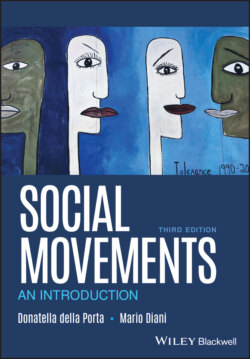Читать книгу Social Movements - Donatella della Porta - Страница 34
2.5 SUMMARY
ОглавлениеIn this chapter, we have asked ourselves whether looking at the social structure and at changes in this may provide a useful key to the interpretation of collective action. We have examined a series of recent modifications to the social and political structure, and their innovative potential in relation to consolidated lines of conflict structuring. The transformation of the economic sphere – in particular, the move to a more or less advanced service and administrative sector and the decentralization of industrial production – has undermined not only the numerical consistency of the working class but also the living and working conditions which facilitated class action. Today, we face greater diversity in professional roles and interests. On the political side, the legitimacy of the state is called into question both by the tendency toward globalization and by that toward localization, but also by a retreat of the state in the face of the market. Furthermore, the capacity of the state to create and reproduce social groups through public intervention has led to an increasing number of demands which are fragmented and increasingly difficult to mediate. New potential for conflict originates therefore in the increasingly blurred borders between the public and the private spheres, particularly from the multiplication of criteria to define rights of citizenship and the growing capacity for intervention among public and private institutions, in areas of private life such as physical and mental health. Conflicts developed around the definition of new identities with particular attention to cultural issues, lifestyles, knowledge.
Mobilizations and movements have developed in recent years around interests involving actors who can be associated in various ways with the transformations that we have just reviewed. Scholars such as Touraine have identified the central conflicts in postindustrial society in struggles for the control of symbolic production. Others have emphasized the high level of involvement of new middle‐class members in new conflicts, as a result of their particular professional position and of the intellectual resources that they control. However, the flexibilization of the labor market has produced increasing poverty in the North and the South; and the attack on the welfare state by dominant neoliberal and free market economic policies has produced the return of protest on “materialistic” issues of social justice.
It is important, however, to remember that collective action does not spring automatically from structural tensions. In this respect, it is still doubtful that a new political cleavage, with the capacity to structure conflicts similar to that demonstrated by the capital–labor or the center–periphery cleavages in industrial society, has emerged, let alone been consolidated. Numerous factors determine whether this will occur. These factors include the availability of adequate organizational resources, the ability of movement leaders to produce appropriate ideological representations, and the presence of a favorable political context. The rest of our book is dedicated to the mechanisms that contribute to an explanation of the shift from structure to action.
